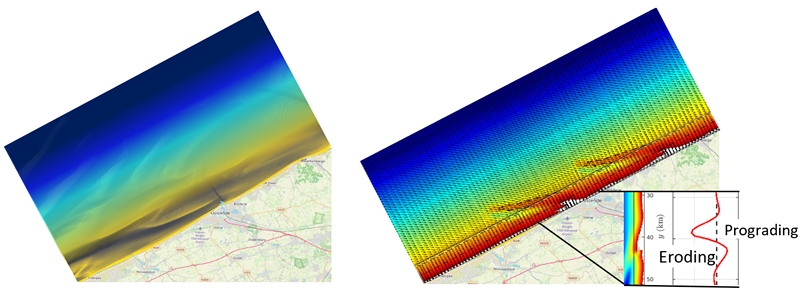J.M. Boersma1*, A. Nnafie1, H. de Swart1
1 Institute for Marine and Atmospheric research Utrecht (IMAU);
*corresponding author:
Introduction
Coastal evolution, in particular erosion, is a major concern for many communities around the world, as it can lead to the loss of valuable property and infrastructure, as well as to the degradation of natural habitats. In order to mitigate and adapt to this threat, it is important to understand the complex processes that contribute to erosion. One factor that can have a significant impact on the evolution of coastlines is the presence of shoreface-connected sand ridges (SFCR), which are bedforms with a scale of several kilometres and with crests that are obliquely oriented with respect to the coastline. This is exemplified at the Belgian coast, where the onshore propagation of SFCR destabilizes the coastline, thereby requiring the need for nourishment of growing size and costs. SFCR have been recognized to cause undulations of the adjacent coastline of Fire Island (USA). The ridges at this location are rather oblique, are present at a considerable distance to the coast and local hydrodynamic conditions are microtidal and a unidirectional wave climate (Safak et al., 2017). This research specifically expands our understanding of such coastline dynamics in the presence of 1) significant tides, 2) a bi-directional wave climate and 3) almost shore-parallel, onshore located and onshore migrating sand ridges, as found along the Belgian shore.
Methods
In this project an idealized numerical modelling approach is used, following the method of Nnafie et al., (2021). The decadal shoreline evolution of the Belgian coast is simulated by forcing a morphodynamic, non-linear shoreline model (Q2Dmorfo) with waves that are obtained from a morphostatic shelf model (Delft3D + SWAN). The latter computes wave propagation on an idealized shelf bathymetry in the presence of tides.
Results
The model is applied to quantify the decadal shoreline evolution of the Belgian coast for different locations and orientations of SFCR and for different wave climate scenarios (see figure below for a typical result). In particular, potential erosion hotspots will be identified and explained.

Figure 1: Shoreface-connected sand ridges (SFCR) at the Belgian coast (left) and a typical result of the simulated shoreline evolution in presence of SFCR (right)
References
Nnafie, A. et al., (2021). Long-term morphodynamics of a coupled shelf-shoreline system forced by waves and tides, a model approach. Journal of Geophysical Research, 126(12): e2021JF0063
Safak, I. et al., (2017). Persistent shoreline shape induced from offshore geologic framework: Effects of shoreface connected ridges. Journal of Geophysical Research: Oceans, 122(11), 8721–8738. https://doi.org/10.1002/2017JC012808
I. Surname1*, F.N. Another-Surname2 , Y. Next-Surname2
1 University Name, Country; 2 Organization Name, Country
* Corresponding author: mail.name@organization.org


